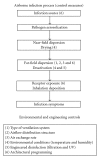Preventing airborne disease transmission: review of methods for ventilation design in health care facilities
- PMID: 22162813
- PMCID: PMC3226423
- DOI: 10.4061/2011/124064
Preventing airborne disease transmission: review of methods for ventilation design in health care facilities
Abstract
Health care facility ventilation design greatly affects disease transmission by aerosols. The desire to control infection in hospitals and at the same time to reduce their carbon footprint motivates the use of unconventional solutions for building design and associated control measures. This paper considers indoor sources and types of infectious aerosols, and pathogen viability and infectivity behaviors in response to environmental conditions. Aerosol dispersion, heat and mass transfer, deposition in the respiratory tract, and infection mechanisms are discussed, with an emphasis on experimental and modeling approaches. Key building design parameters are described that include types of ventilation systems (mixing, displacement, natural and hybrid), air exchange rate, temperature and relative humidity, air flow distribution structure, occupancy, engineered disinfection of air (filtration and UV radiation), and architectural programming (source and activity management) for health care facilities. The paper describes major findings and suggests future research needs in methods for ventilation design of health care facilities to prevent airborne infection risk.
Figures
Similar articles
-
Air cleaning technologies: an evidence-based analysis.Ont Health Technol Assess Ser. 2005;5(17):1-52. Epub 2005 Nov 1. Ont Health Technol Assess Ser. 2005. PMID: 23074468 Free PMC article.
-
Ventilation strategies and design impacts on indoor airborne transmission: A review.Build Environ. 2022 Jun 15;218:109158. doi: 10.1016/j.buildenv.2022.109158. Epub 2022 May 6. Build Environ. 2022. PMID: 35573806 Free PMC article. Review.
-
[Ventilation concepts in schools for the prevention of transmission of highly infectious viruses (SARS-CoV-2) by aerosols in indoor air].Bundesgesundheitsblatt Gesundheitsforschung Gesundheitsschutz. 2021 Dec;64(12):1570-1580. doi: 10.1007/s00103-021-03452-4. Epub 2021 Nov 5. Bundesgesundheitsblatt Gesundheitsforschung Gesundheitsschutz. 2021. PMID: 34739549 Free PMC article. Review. German.
-
A pilot study to investigate the effects of combined dehumidification and HEPA filtration on dew point and airborne mold spore counts in day care centers.Indoor Air. 2005 Dec;15(6):402-7. doi: 10.1111/j.1600-0668.2005.00379.x. Indoor Air. 2005. PMID: 16268830
-
A review of strategies and their effectiveness in reducing indoor airborne transmission and improving indoor air quality.Environ Res. 2022 Oct;213:113579. doi: 10.1016/j.envres.2022.113579. Epub 2022 Jun 14. Environ Res. 2022. PMID: 35714688 Free PMC article.
Cited by
-
Modeling of the Transmission of Coronaviruses, Measles Virus, Influenza Virus, Mycobacterium tuberculosis, and Legionella pneumophila in Dental Clinics.J Dent Res. 2020 Sep;99(10):1192-1198. doi: 10.1177/0022034520940288. Epub 2020 Jul 2. J Dent Res. 2020. PMID: 32614681 Free PMC article.
-
Air circulation in a gastrointestinal light source box and endoscope in the era of SARS-CoV-2 and airborne transmission of microorganisms.Endosc Int Open. 2021 Mar;9(3):E482-E486. doi: 10.1055/a-1336-3280. Epub 2021 Feb 22. Endosc Int Open. 2021. PMID: 33655053 Free PMC article.
-
Diversity of bacterial communities of fitness center surfaces in a U.S. metropolitan area.Int J Environ Res Public Health. 2014 Dec 3;11(12):12544-61. doi: 10.3390/ijerph111212544. Int J Environ Res Public Health. 2014. PMID: 25479039 Free PMC article.
-
Synthesis of TiO2-SiO2-Ag/Fiberglass with Antibacterial Properties and Its Application for Air Cleaning.ACS Omega. 2023 Jun 20;8(26):23521-23527. doi: 10.1021/acsomega.3c00969. eCollection 2023 Jul 4. ACS Omega. 2023. PMID: 37426213 Free PMC article.
-
A Review of CAC-717, a Disinfectant Containing Calcium Hydrogen Carbonate Mesoscopic Crystals.Microorganisms. 2025 Feb 25;13(3):507. doi: 10.3390/microorganisms13030507. Microorganisms. 2025. PMID: 40142400 Free PMC article. Review.
References
-
- Wan MP, Sze-To GN, Chao CYH, Fang L, Melikov A. Modeling the fate of expiratory aerosols and the associated infection risk in an aircraft cabin environment. Aerosol Science and Technology. 2009;43:322–343.
-
- Atkinson J, Chartier Y, Pessoa-Silva CL, Jensen P, Li Y, Seto WH. World Health Organization (WHO) Publications/Guidelines; 2009. Natural ventilation for infection control in health-care settings. Tech. Rep. - PubMed
LinkOut - more resources
Full Text Sources
Other Literature Sources


